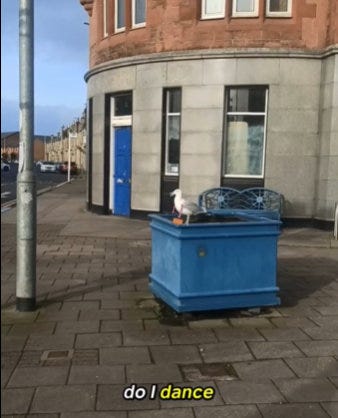Why It Might Not Sink In Until You've Written It Down
Typing isn't all that, if you want to actually *remember* anything.
Hello! This is Everything Is Amazing, a newsletter about science, curiosity and wonder.
Firstly - thank you so much for your very kind comments and many replies about my last newsletter on the fickle mechanics of ‘going viral’, which I thought would be of interest to, ehhhhhh, about a dozen of you? Not so, it turns out! I’m very grateful.
(But since that’s about the limit of everything I know about marketing, social media and modern society in general, I will be getting straight back to telling science stories. Hope that’s okay.)
Secondly: last week, on the way to my normal coffee shop, I spotted a bird doing a very odd thing:
What I didn’t realise at the time is that this gull is charming worms.
Worm-charming (also called worm-grunting or worm-fiddling) is the act of creating vibrations at the surface of the ground to draw worms out. I’d completely forgotten it until now, but when I was a kid, my dad taught me to do it with a garden fork - you stick it in the soil, you yank it back and forth until the soil’s compacted enough on either side of the prongs to make a decent thudding noise - and then you thump away. This brings all the worms to the yard.
But of course, we humans didn’t invent any of this. We copied it from birds. When gulls dance madly like the one on my home town’s municipal planter, they’re tricking their lunch into making an appearance.
Science fiction fans: yes, this is exactly the inspiration for the ‘thumpers’ that the Fremen use to attract the colossal sand-worms in Frank Herbert’s Dune - making that gull the Paul Atreides of the bird world…
All well and good and fascinatingly sciencey.
But when I put this video up on Threads, a few people tagged Sam Cotton, actor, writer and maker of hilarious & extremely absurd bird-related cartoons on Instagram.
He contacted me to see if I’d be willing for him to use the footage, I said yes - and last night, he posted this to his 1 million+ followers:
Utter madness, and I’m gladly here for it.
Anyway! Today, an update from this season’s look at the science of having a good memory - and, as usual, it’s taken me in a direction I wasn’t expecting.
The rest of this one is for paid subscribers. But since most of you aren’t, and I really don’t want to miss the opportunity to shout the praises of the following newsletter to you, which I’m mentioning later in this piece - please click through to
‘s wonderful Noted, which is an endless treat for notebook enthusiasts:Okay. It’s time for some memory-science I wasn’t expecting.
Everything I investigate for this newsletter usually follows a pattern:
I think I already know something about it - maybe a lot! Ahhh yeah. I’ve got this.
I rapidly discover there’s more to learn that’s way more interesting than the relatively, painfully little I thought I knew…
I find that thing I thought I knew was either simplistic or just feeble rubbish. Great.
This means that sometimes, these newsletters sound like I’ve done a lot of sensible reading and have a pretty good handle of the facts (I think this is a good example, or this one on the importance of hobbies) - but other times, they sound like the excitable babblings of someone surprised and also a bit disconcerted about how surprised he is (this piece on plastic rocks and technofossils might qualify here).
This topic is proving no different. Researching this edition, about what it’s like to live without a working long-term memory, sent me hurtling into a lot of reading that will prove useful later in the season, but also skipped over something fundamental that I need to address right now, before we go any further.
There is a strong temptation - which, it seems from my reading to date, layman writers like me often succumb to - to view memory improvement as an exercise in mental discipline that has nothing to do with anything but your mighty force of will. It’s just an inner battle with yourself that you should be able to do under any circumstances, so in the great tradition of Western intellectuals, you should be prepared to sit down, rest your chin on your hand like Rodin’s famous sculpture, and bloodymindedly wrestle your mind down onto the mat until it gives up.
(You can certainly see why this approach appeals to certain macho types that only get motivated by conflict metaphors.)
I started writing about memory with the same assumption. But then I learned how blindfolded chess Grandmaster Timur Gareyev used his exercise bike - and through science writer Annie Murphy Paul I started to learn about the role that place and physiology (ie. where we are and what our bodies are doing) play in the process of thinking, of which remembering is always a huge part.
(A quick note on Gareyev: his achievements within chess may be brilliant, but a huge question mark currently hovers over him as a human being, thanks to these allegations. I’ll keep an eye on this story and update my original piece accordingly.)
So yet again, I’ve had to back up from where I thought I needed to go. This is almost always a sign I’m on the right track (yay for the overturning of lazy assumptions!) but it also makes for a somewhat chaotic narrative. Where to actually begin? What comes first? What?
Let’s start with the way our educational systems teach us to remember things…




